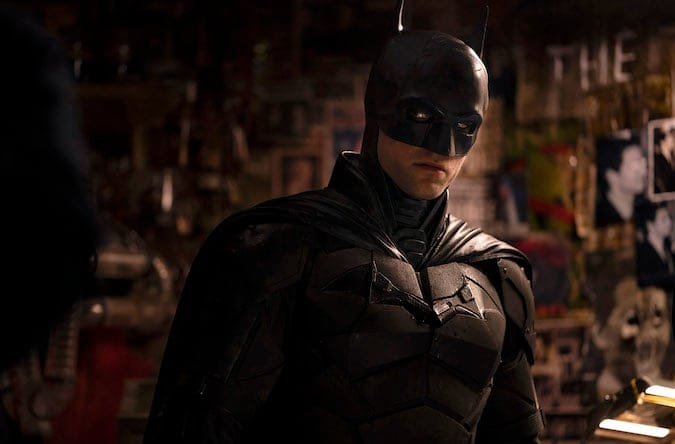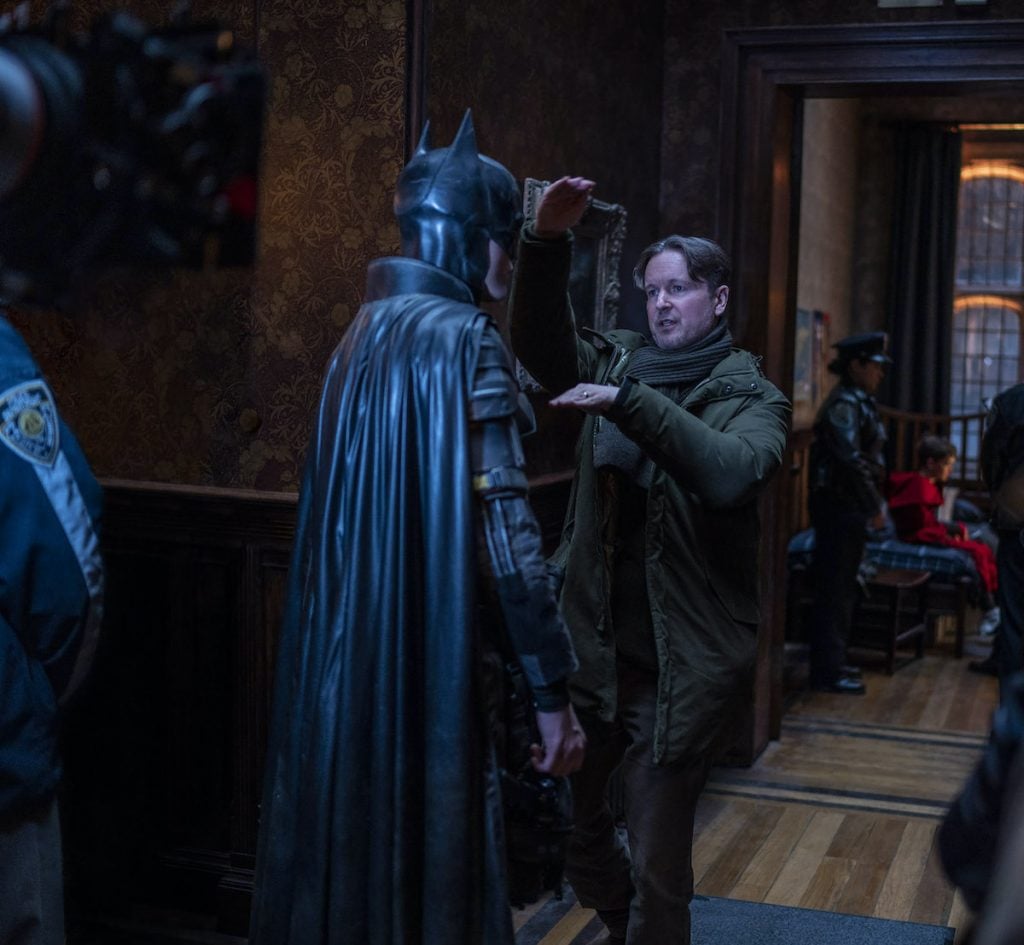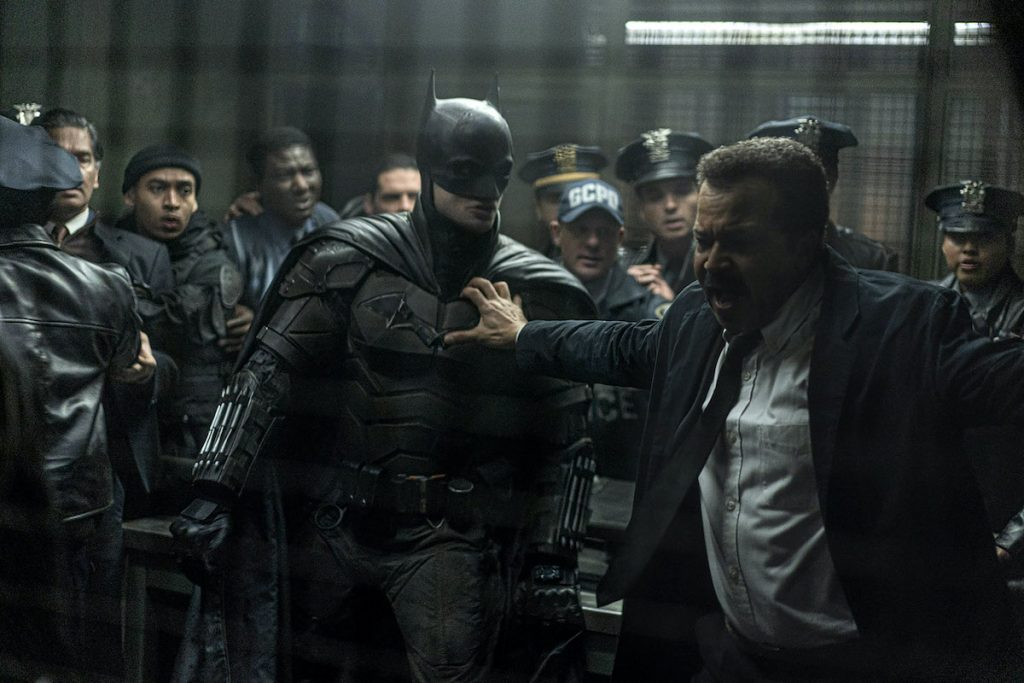
(The following interviews with The Batman director Matt Reeves and stars Robert Pattinson, Zoë Kravitz, Jeffrey Wright, Colin Farrell and producer Dylan Clark contain no plot spoilers — but do detail Reeves’ vision for the film.)
What everyone involved in The Batman mentions about director Matt Reeves is his specificity.
“There were times when I thought, maybe we don’t need that comma there,” says Jeffrey Wright, who plays the incorruptible Gotham cop Lt. James Gordon. “And he’s like, ‘Wait a minute — that comma relates to a comma in the next scene. If you take that one out, then it changes the value of the next one.’ It’s a really tightly woven script.”
Speaking to Wright, a few months before the film’s release, I assumed he was kidding about the comma — trying to make a point about Reeves’ exactitude without giving away any plot points of the most-anticipated movie of 2022.
So I asked Reeves.
“I’m sure that is true,” he says, adding: “Hearing that makes me feel somewhat bad.”
We’re speaking over Zoom, and his hair and mustache make him look a little like a cross between Ethan Hawke and the version of Jim Gordon played by Gary Oldman in Christopher Nolan’s Batman films. His response, like his thinking about the comma, is patient, deliberative, and a little apologetic for being so deliberative.
“The first thing that I’m doing when I’m working is I’m trying to internalize everything. Because if I have it internalized, then my compass is functional,” Reeves explains. “So I’m trying to feel what it would be like for everybody. But I am not the actor that any of these people are — I’m just an actor on paper in my head, and in a vision, and I have an instinct about what the emotional path is.
“When Jeffrey comes in, he has so many great ideas. He’s an amazing actor, so he brings something to life. So the last thing I’d want to do is to have him do it the way I would do it, because it won’t be nearly as good,” he explains. “But the specificity of the comma has to do with emphasis — and that is narrative. There are moments when the comma is narrative, the comma is something that sets something apart that’s going to come back in an important way. And this story, in particular, is the most intricate narrative I have ever, ever tried to tackle.”
The details really do matter, says Robert Pattinson, who plays Bruce Wayne and Batman, two personalities who are painfully intertwined in The Batman. Pattinson says he was worried at first when Reeves would ask for a lot of takes.
“Your first thought is, Oh my God, I’m absolutely terrible,” he laughs, with trademark self-deprecation. But when Reeves would show him the playback of scenes, which Reeves likes to do, he began to see the same make-or-break nuances the director did. For example, the mask. The Batman cinematographer Greig Fraser, who also shot Rogue One: A Star Wars Story, told Pattinson early on: “The two most difficult things to light are Darth Vader’s helmet and the cowl.”
Won’t You Take 10 Seconds to Sign Up for Our Newsletter?
“There’s a whole different language, body language, you have to learn to make it do what you want it to do,” says Pattinson. “If you look too much into the light, it looks completely ridiculous, and you’re wearing a Halloween costume. But if you’re like two millimeters down, it’s like — oh, that’s completely totemic, and like it looks exactly how it’s supposed to look. But to learn how to feel that and learn how to react to how the light hits it, takes forever.
Every millimeter matters.
“There was a scene where I — Selina — was coming out of a club and I’m upset,” recalls Zoë Kravitz, who plays Selina Kyle, aka Catwoman. “And he said, ‘You know, you walk out and you’re upset and your mouth is kind of open, because you’re breathing, because you’re emotional. And then you’re closing your mouth, but we’re just kind of getting rid of the emotion, just slightly. So try to just keep your mouth relaxed the same way.’ But then I watched back and I can see the difference. And I was like, ‘You are a freak and I love it.’”

Besides directing The Batman, Reeves co-wrote the script with Peter Craig. “Every day, night and day, he eats, drinks, sleeps Batman, and all the characters in this mythology,” says Colin Farrell, who plays Oz, aka The Penguin. “He’s no doubt hunched over a monitor as we speak, still finishing putting the final touches together.”
“Matt is the most specific person and director I’ve ever worked with,” adds Kravitz. “And I really think it’s one of his biggest strengths. I think sometimes he beats himself up about it, because he can probably drive himself almost crazy sometimes. But his specificity is really beautiful, especially in a film like this where it can be so easy to just focus on the big action sequences or the explosions. And he will pay attention to the way you put down a cup.”
A puzzle is its pieces. A mystery is its clues. The Batman is assembled and informed by Reeves’ reverence for films released in his 1970s childhood — conspiratorial thrillers including Klute, Chinatown, and All the President’s Men.
Every detail is important, because this Batman, more than any before it, is a detective story.
Disappearing
In the 1950s, Reeves’ dad got a Super 8 camera. His sister, 13 years older, married a New York detective, and together they had a huge family, and Reeves’ dad shot their home movies. Eventually, he gave the camera to his father-in-law, Reeves’ grandfather.
If that sounds overly complicated, just remember:
Detective.
Camera.
Matt Reeves was born in 1966, the same year the Batman TV series premiered. His parents soon moved from New York to Los Angeles. But his father hadn’t completely left his old life behind.
“There was always a bit of that kind of volatile New Yorker in him,” says Reeves. “Which to me is very Gotham.”
One day, when his grandparents were visiting from the East Coast, the family went to Marineland, a tourist attraction where guests could watch killer whale shows, feed seals, pet dolphins, and snorkel in a vast aquarium filled with fish — even sharks.
“I saw these tourists filming the dolphins with their camera,” says Reeves. “And the idea so tickled me — I was like, Oh my God, here we are seeing the dolphins, but they’re filming them. So they’re going to bring the dolphins home. And anytime they want, they’ll be able to put the dolphins on their wall. It blew me away. That concept was so exciting to me.
“And my grandfather said, ‘Well, you know, I have a little wind-up eight-millimeter camera — do you want it?’” Reeves recalls. “So when they went back to New York, they sent it back to me.”
The camera became an escape.
“I just started making movies on this little windup camera. And it was like, that became for me, the tool of socialization, the way of creating meaning, of having a little control, of doing something creative. So a camera became my lifeline, to be honest with you. I got very into movies from a young age.”
He took to filmmaking almost immediately.
“I remember one of the first things I did was — and my mother even to this day still talks about it as if it was miraculous, and of course, anyone that knows anything about cameras knows that of course it isn’t — but I took the camera, I didn’t have a tripod, and I put it on this little brick wall that was in front of our apartment building. I wound it up, I turned it on, I stood there, and then it turned off. And then I moved and turned it back on, and made myself disappear. And I showed my mother and she was like, ‘Oh my God, he’s a genius.’”
“The kind of manipulation that you can do with a camera is magical,” he discovered. “And I think for me, that magic is something that just got in my blood very early.”
Reality could be harder.
“My parents… had a very volatile relationship,” he says. “And they fought bitterly at times.”
“I love my parents,” he explains. “I think they loved each other deeply. But they also were deeply wounded by each other. And it was something that honestly never resolved.”
“And also, I was shy,” he adds. “And so as a kid, you know, moviemaking was a way for me to — it was a bridge for me to go up to someone and say, ‘Hey, you want to make a movie?,’ which I would never have had the courage to do if I didn’t have the cover of the camera. That’s the metaphor for friendship, right?”
One of Reeves’ films, 2008’s Cloverfield, is built around one character agreeing to videotape his friends at a party because it will give him an excuse to talk with his crush. Another of his films, 2010’s Let Me In, a remake of the 2008 Swedish film Let the Right One In, includes a scene when bullies mock a little boy, calling him a little girl.
“That was very personal for me, because I always, you can even see now, I have a high voice. I’m often mistaken on the phone for being a woman,” he says. “And some kids were pretty brutal to me.”

One of the friends he made through filmmaking was J.J. Abrams. They got their films on public access TV by their early teens, then into a 1982 Los Angeles film festival at the Nuart Theatre, highlighting 8mm films made by teens. They drew the attention of Steven Spielberg, who enlisted Abrams and Reeves to clean up the Super 8 films that he himself had made as a teen. Then Reeves got into USC, where one of his films was scheduled to play at the First Look showcase. Agents would be there, and producers, and assistants, looking for the next Spielberg.
But his parents would also be there. And at the time of the festival, a restraining order required them to stay 150 feet apart from each other.
“That moment in time for a film student is a critical moment. And the thing that I was thinking of the most that night was that both my parents would be under the same roof in that theater. And I thought of them as antimatter and matter. And I thought, if they get too close, this whole place will blow up.”
The tension between his parents never ended, until his father’s death in 2016. But Reeves had escaped into the world of moviemaking.
An assistant to director-producer Ed Zwick had seen his student film. So had an agent at CAA. He was on his way. And he had spent his childhood and teenage years accumulating a fierce and abundant film knowledge that would fuel everything that would come next, including:
—the 1994 David Schwimmer-Gwyneth Paltrow comedy The Pallbearer, which Reeves made in his late 20s, aspiring to a “Hal Ashby sad comedy, you know, that kind of thing”;
—Felicity, the beloved Keri Russell college drama Reeves and Abrams created together;
—the Abrams-produced Cloverfield, which proved Reeves could lead an emotionally grounded blockbuster;
—Let Me In, which displayed his gift for finding deeply personal meaning from others’ original material;
—two smash Planet of the Apes sequels, which embraced and escalated the original franchise’s big questions about what it means to be human.
And now, the biggest movie of them all.
Welcome to Gotham
Syndicated Batman episodes provided a joyous, colorful backdrop to many 1970s childhoods. But also lurking in the background were frequent references to something called Watergate, a real-life cynical political drama that in 1974 brought down the president of the United States.
Two key characters in The Batman — Gotham Mayor Don Mitchell Jr. (Rupert Penry-Jones) and District Attorney Gil Colson (Peter Sarsgaard) — share last names with key figures in the Watergate scandal, which is portrayed in the 1976 ripped-from-the-headlines film All the President’s Men. In real life, President Nixon’s advisor and hatchet man, Chuck Colson, was the first member of the administration to be imprisoned for his political dirty work. John N. Mitchell was Nixon’s campaign manager, a proponent of “law and order” sentenced to prison for multiple Watergate-related crimes. News of the scandal broke thanks in large part to the work of sleuthing reporters Bob Woodward and Carl Bernstein (Robert Redford and Dustin Hoffman in the movie, which was directed by Alan J. Pakula and written by William Goldman, based on Woodward and Bernstein’s book).
Continue for more of Matt Reeves on The Batman
